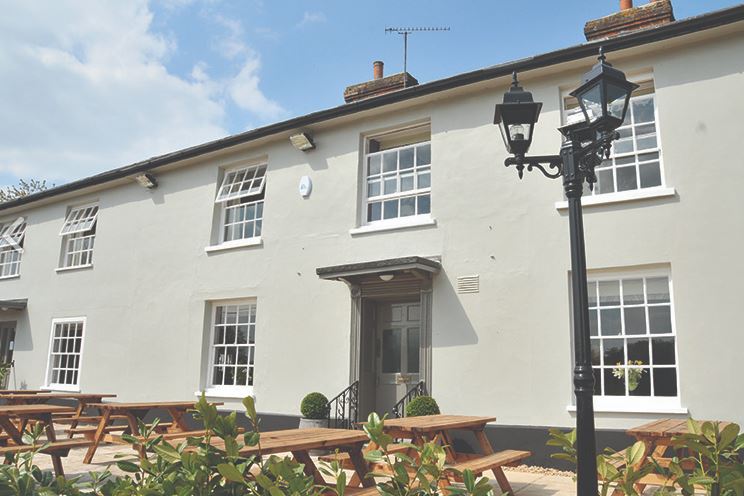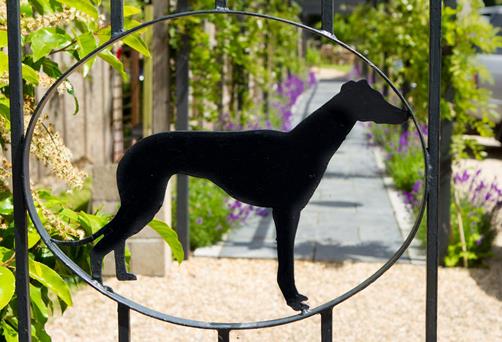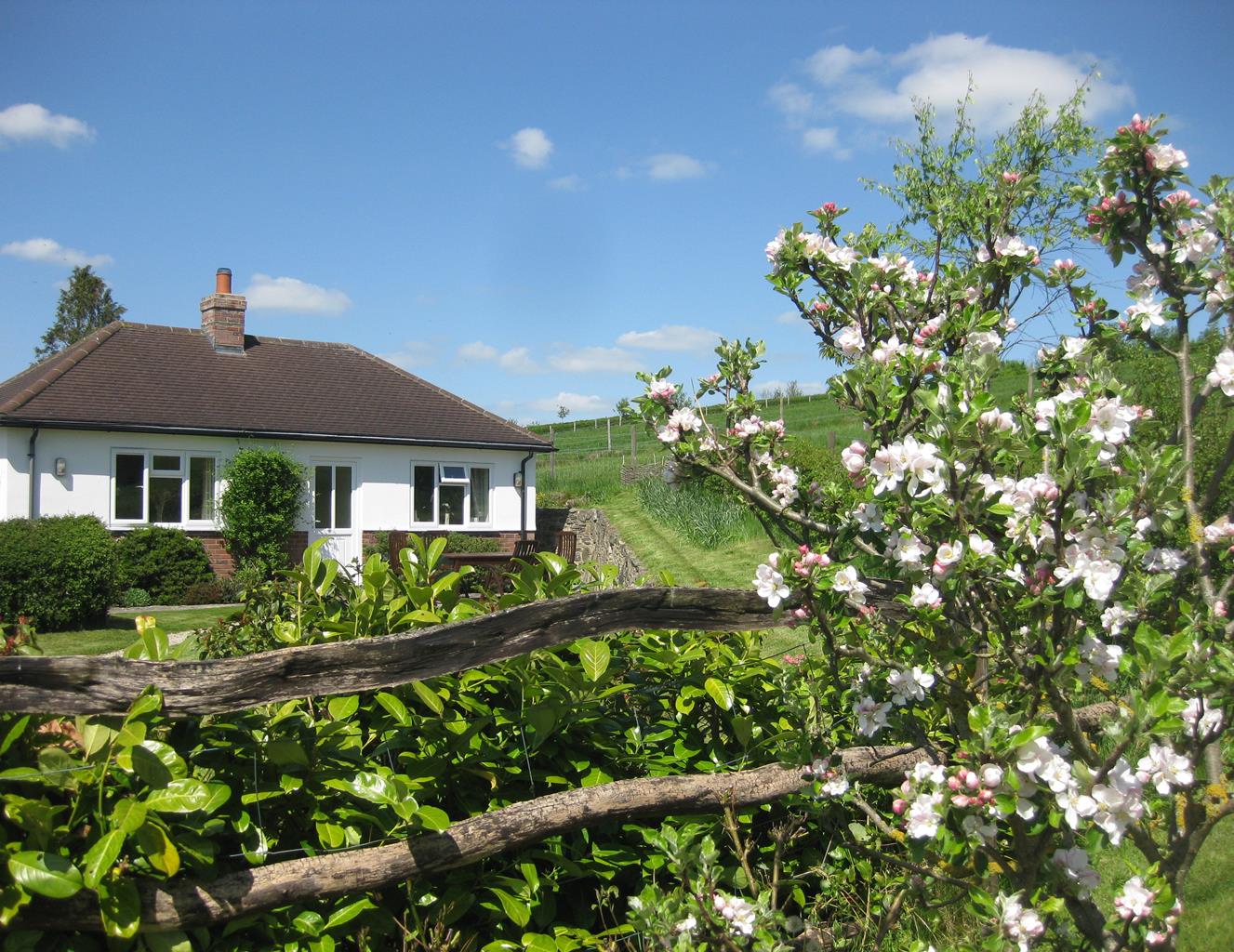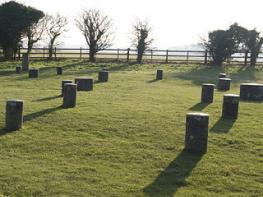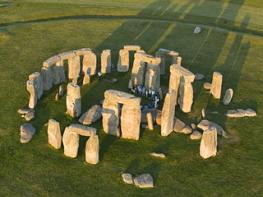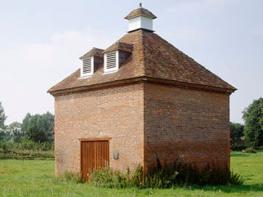Dating from 16th-century, and now Grade 2-listed, The George is centrally located in Amesbury.…
Amesbury and the Woodford Valley

6.5 miles (10.4kms)
About the walk
Amesbury is a pleasant market town set in a bend of the River Avon, which is crossed by a five-arched bridge built in Palladian style. Its proximity to the eastern edge of Salisbury Plain means that the neighbourhood is dominated by large military camps, including the experimental flying base of Boscombe Down. Despite this, the lesser-known chalk downland and the beautiful Woodford Valley to the south of the town remain delightfully unspoilt. Criss-crossed by breezy byways and tranquil riverside paths, it is perfect walking country with archaeological treasures such as Bronze Age barrows and of course Stonehenge, and chocolate-box villages.
Amesbury Abbey
According to legend, Amesbury was founded by an uncle of King Arthur, a Roman Briton named Ambrosius Aurelianus, hence the name Amesbury. After Arthur's death in the 6th century ad, it is said that Queen Guinevere sought refuge in the Wessex region, probably retreating to Amesbury Abbey. The abbey was succeeded in ad 979 by a nunnery, which eventually became the richest in England. It achieved fame as the refuge of Mary, daughter of Edward I, and her grandmother Queen Eleanor, Henry III's widow. After the Dissolution of the Monasteries in 1540, the convent was demolished and a house was built on the site. This was replaced in 1661 by a new mansion, designed by John Webb in the style of Inigo Jones, his father-in-law. Here, the handsome and hospitable Duchess of Queensberry inspired John Gay to write The Beggar's Opera (1728).
The present Amesbury Abbey was rebuilt in 1840 by Thomas Hopper for Sir Edward Antrobus, owner of the Stonehenge Estate. Although it is now a nursing home, you can see the colonnaded front from the impressive neoclassical entrance in Church Street. Amesbury's ancient and atmospheric church is all that remains of the original abbey. Built by the Saxons and remodelled by the Normans, it has a fine example of an early 14th-century window in the chancel, striking tracery and carved bosses.
The meandering River Avon threads its way south from Amesbury for 7 miles (11.3km), flowing through the Woodford Valley to Salisbury in the Avon Valley. Peaceful and protected, it is the perfect setting for some of Wiltshire's finest villages, notably the three Woodfords and Great Durnford, the quintessential English village with its converted mill, weeping willows, picture-postcard thatched cottages with flower-filled gardens, impressive Norman church and handsome manor house. Take time to visit the church and, if the pub is open, relax with a pint in the garden, which overlooks the lush water-meadows.
Walk directions
Take the footpath to the right of the play area, cross a footbridge and bear right to cross the main footbridge over the River Avon. At a crossing of tracks, take the track straight ahead, passing to the right of cottages. Head uphill to a junction and go straight on, downhill to a gate. Turn right along the field-edge and bear left in the corner to join a path that passes through the valley bottom beside a stream to shortly cross a footbridge on your right.
Follow the path through marshy ground to cross a bridge over the Avon. Bear right over a small bridge and keep left through a paddock beside the thatched cob wall of a farm to a gate. Bear right along the fenced path beside the drive to the road. Turn left then, in 0.25 miles (400m), reach a right turn.
Either walk up the tarmac road towards Springbottom Farm or join the path through the spinney on your right for views across to Stonehenge. Pass a covered reservoir and some barns, then descend to the farm complex. Just beyond the barns, bear left with a red byway arrow on to a track beside paddocks.
Keep to this track through the downland valley (Lake Bottom) for nearly one mile (1.6km). Where it becomes metalled take the arrowed path right, between new fences, into woodland and bear left uphill. Cross a stile and continue ahead. Once out of the trees, keep right along the field-edge, with views left to Lake House, to a stile.
Cross the lane and take the bridle path right in front of a thatched house. Go past (not through) a gap on your left, to descend gently. Cross a drive and bear left to cross two footbridges over the Avon. Pass beside Durnford Mill and follow the drive out to the lane.
Turn left and walk through Great Durnford, passing the church and drive to Great Durnford Manor, following the public road right, uphill through woodland. Descend and take the waymarked bridle path left beside Fairwood House.
Ascend steeply through the edge of Ham Wood. On leaving the wood, do not curve left and down; bear right along a narrow path through scrub to a gate. Keep right along two fenced field-edges to a gate.
Maintain your direction through the pastureland, not losing height, eventually easing right towards a field boundary corner. Continue for 0.25 miles (400m), following a field-edge. Keeping this line, descend the field-edge to a gate to rejoin your outward route. Retrace your steps back into Amesbury and the car park.
Additional information
Tracks, field and bridle paths, roads, several stiles
River valley and chalk downland
Keep dogs on lead through villages and water-meadows
OS Explorer 130 Salisbury & Stonehenge
Amesbury Recreation Ground car park (free) at end of Recreation Road, off route to West Amesbury
Amesbury
WALKING IN SAFETY
Read our tips to look after yourself and the environment when following this walk.
Find out more
Also in the area
About the area
Discover Wiltshire
A land shrouded in mystery, myth and legend, Wiltshire evokes images of ancient stone circles, white chalk horses carved into hillsides, crop circles and the forbidden, empty landscape of Salisbury Plain. To many M4 and A303 drivers heading out of London through the clutter of the Thames Valley, Wiltshire is where the landscape opens out and rural England begins.
Wiltshire’s charm lies in the beauty of its countryside. The expansive chalk landscapes of the Marlborough and Pewsey downs and Cranborne Chase inspire a sense of space and freedom, offering miles of uninterrupted views deep into Dorset, Somerset and the Cotswolds. Wiltshire’s thriving market towns and picturesque villages provide worthwhile visits and welcome diversions. Stroll through quaint timbered and thatched villages in the southern Woodford and Avon valleys and explore the historic streets of the stone villages of Lacock, Castle Combe and Sherston. Walk around Salisbury and discover architectural styles from the 13th century to the present and take time to visit the city’s elegant cathedral and fascinating museums. And if all of that isn’t enough, the county is also richly endowed with manor houses, mansions and beautiful gardens.
Nearby stays
Restaurants and Pubs
Nearby experiences
Recommended things to do
Why choose Rated Trips?
Your trusted guide to rated places across the UK
The best coverage
Discover more than 15,000 professionally rated places to stay, eat and visit from across the UK and Ireland.
Quality assured
Choose a place to stay safe in the knowledge that it has been expertly assessed by trained assessors.
Plan your next trip
Search by location or the type of place you're visiting to find your next ideal holiday experience.
Travel inspiration
Read our articles, city guides and recommended things to do for inspiration. We're here to help you explore the UK.




